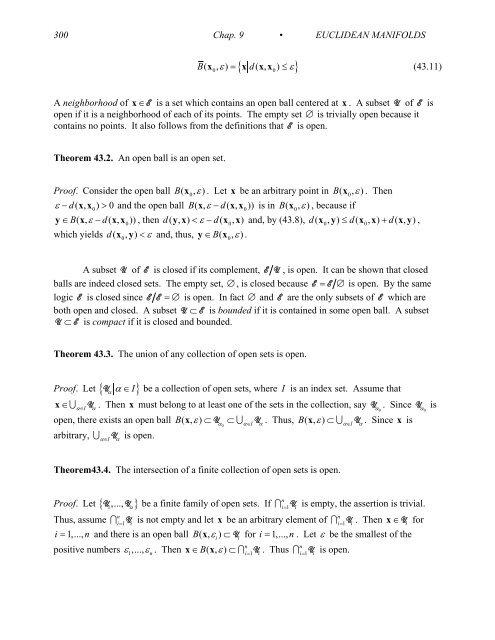Introduction to Vectors and Tensors Vol 2 (Bowen 246). - Index of
Introduction to Vectors and Tensors Vol 2 (Bowen 246). - Index of
Introduction to Vectors and Tensors Vol 2 (Bowen 246). - Index of
Create successful ePaper yourself
Turn your PDF publications into a flip-book with our unique Google optimized e-Paper software.
300 Chap. 9 • EUCLIDEAN MANIFOLDS<br />
{ d ε}<br />
B( x , ε ) = x ( x, x ) ≤<br />
(43.11)<br />
0 0<br />
A neighborhood <strong>of</strong> x ∈E is a set which contains an open ball centered at x . A subset U <strong>of</strong> E is<br />
open if it is a neighborhood <strong>of</strong> each <strong>of</strong> its points. The empty set ∅ is trivially open because it<br />
contains no points. It also follows from the definitions that E is open.<br />
Theorem 43.2. An open ball is an open set.<br />
Pro<strong>of</strong>. Consider the open ball B( x<br />
0, ε ). Let x be an arbitrary point in B( x<br />
0, ε ). Then<br />
ε − d( xx ,<br />
0) > 0 <strong>and</strong> the open ball B( x, ε − d( x, x<br />
0))<br />
is in B( x<br />
0, ε ), because if<br />
y ∈B( x, ε −d( x, x<br />
0))<br />
, then d( y, x) < ε −d( x0, x ) <strong>and</strong>, by (43.8), d( x0, y) ≤ d( x0, x) + d( x, y ),<br />
which yields d( x0, y ) < ε <strong>and</strong>, thus, y∈ B( x<br />
0, ε ).<br />
A subset U <strong>of</strong> E is closed if its complement, EU, is open. It can be shown that closed<br />
balls are indeed closed sets. The empty set, ∅ , is closed because E = E ∅ is open. By the same<br />
logic E is closed since EE =∅ is open. In fact ∅ <strong>and</strong> E are the only subsets <strong>of</strong> E which are<br />
both open <strong>and</strong> closed. A subset U ⊂ E is bounded if it is contained in some open ball. A subset<br />
U ⊂ E is compact if it is closed <strong>and</strong> bounded.<br />
Theorem 43.3. The union <strong>of</strong> any collection <strong>of</strong> open sets is open.<br />
Pro<strong>of</strong>. Let { U<br />
α<br />
α ∈ I}<br />
be a collection <strong>of</strong> open sets, where I is an index set. Assume that<br />
x ∈∪<br />
α∈IUα<br />
. Then x must belong <strong>to</strong> at least one <strong>of</strong> the sets in the collection, say U<br />
α 0<br />
. Since U<br />
α 0<br />
is<br />
open, there exists an open ball B( x, ε ) ⊂Uα ⊂∪ 0 α∈IUα<br />
. Thus, B( x, ε ) ⊂ ∪<br />
α∈IUα<br />
. Since x is<br />
arbitrary, ∪ is open.<br />
U α∈I<br />
α<br />
Theorem43.4. The intersection <strong>of</strong> a finite collection <strong>of</strong> open sets is open.<br />
Pro<strong>of</strong>. Let { }<br />
1 ,..., α<br />
n<br />
U U be a finite family <strong>of</strong> open sets. If ∩ U i= 1 i<br />
is empty, the assertion is trivial.<br />
Thus, assume ∩ n<br />
U is not empty <strong>and</strong> let x be an arbitrary element <strong>of</strong> ∩ n<br />
U . Then i= 1 i<br />
i= 1 i<br />
x ∈U i<br />
for<br />
i = 1,..., n <strong>and</strong> there is an open ball B( x, ε i<br />
) ⊂U i<br />
for i = 1,..., n. Let ε be the smallest <strong>of</strong> the<br />
positive numbers ,..., n<br />
n<br />
ε1 ε<br />
n<br />
. Then x∈B( x, ε ) ⊂∩ i=<br />
1U<br />
i<br />
. Thus ∩ U i= 1 i<br />
is open.

















